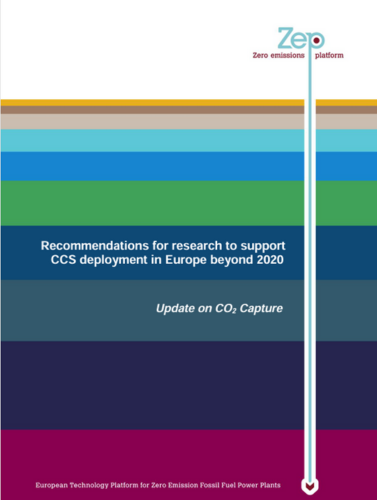Recommendations for research to support CO2 Capture deployment in Europe
About the report
The critical role of CO2 Capture and Storage (CCS) in meeting the EU’s energy, climate, and societal goals
is now indisputable: the European Commission’s communication on CCS has confirmed that it is not only
“vital for meeting the Union’s greenhouse gas reduction targets”, it provides a “very visible link between
jobs in local communities and continued industrial production”. Indeed, CCS must account for 19-32% of
total emissions reductions in the power sector by 2050, which means that “For all fossil fuels, Carbon
Capture and Storage will have to be applied from around 2030 onwards”.
In 2010, ZEP published its ground-breaking report, “Recommendations for research to support the
deployment of CCS in Europe beyond 2020”, which identified the main R&D areas for driving down costs
through well-targeted R&D programmes. FP7-ENERGY calls have taken into account several of the
recommended priorities, developing various key components of the CCS value chain.
Ongoing R&D for CCS is essential to drive down costs – and deliver EU climate targets
In the power sector, first-generation technologies for all three capture pathways (post-combustion, pre-combustion, and oxy-fuel) have already been tested at large pilot-scale facilities and are now ready for the demonstration phase. However, CO2 capture is an emerging technology, and historical experience with comparable processes suggests that significant improvements are achievable through further well-targeted R&D. The optimisation of current and next-generation technologies is therefore essential to further drive down costs, enable rapid deployment post 2020, and deliver EU climate targets.
R&D is also needed to validate capture technologies for use in industries beyond power, expected to deliver half of the global emissions reductions required by 2050 from CCS. Indeed, in some industries,
such as steel and cement, it is the only means of achieving deep emission cuts. As several have almost
pure CO2 streams, this also dramatically reduces the cost of CO2 capture, while clustering different CO2
sources to a transport network will result in significant economies of scale for both industrial and power
projects.
Combined with sustainable biomass, CCS can even remove CO2 from the atmosphere (Bio-CCS5) – the
only large-scale technology that can deliver net negative emissions (in addition to any emissions reductions achieved by replacing fossil fuels with biomass). Certain biofuels production routes could provide ‘low-hanging fruits’ for early, low-cost CCS deployment, and in the US, Bio-CCS is already being deployed at industrial scale.
This report therefore prioritises immediate R&D needs of CO2 capture, focusing mainly on the power sector, while identifying the need to verify industrial applications – taking into account advances achieved to date and future requirements to drive down costs.
Future R&D programmes must also allow for new, breakthrough technologies
While long-term R&D needs have been identified for CO2 capture technologies known today, novel technologies – or the novel use of known technologies – are likely to be presented in the years to come. It is therefore vital that future R&D programmes are formulated in such a way that breakthrough technologies can be incorporated and given a fair evaluation.
Such technologies must not only be advanced and innovative, but have the potential to effect improvements compared to first-generation technologies – mainly in terms of cost and efficiency. They will then have to undergo the full development product cycle (laboratory – small/large pilot – demonstration pre-commercial (first-of-a-kind) – commercial). Finally, it is essential to recognise the need for large-scale pilots, which are risky and costly to carry out and therefore a limiting factor for new developments.
